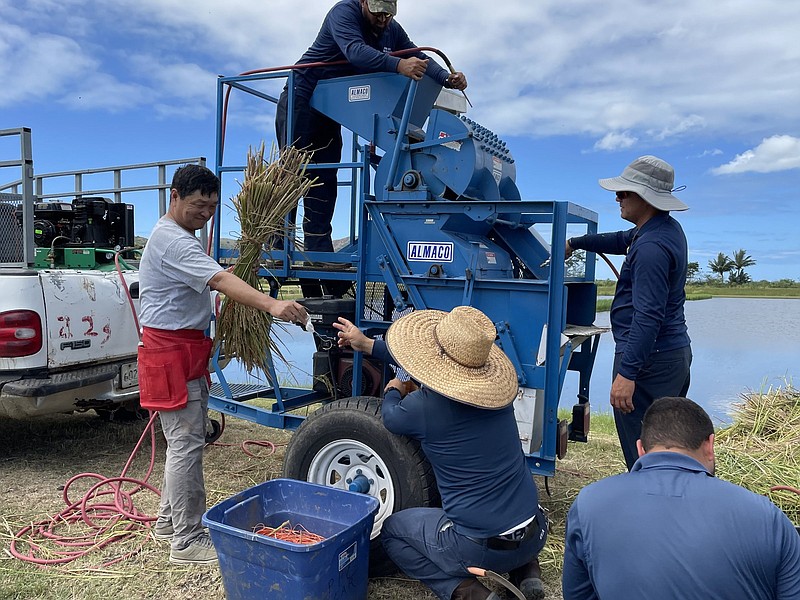The Arkansas Agricultural Experiment Station's Rice Breeding Program's off-season harvest in the U.S. territory of Puerto Rico pulled in a record amount of rice breeding materials this year for ongoing experiments and seed increases.
The rice research site at the University of Puerto Rico-Mayaguez's Lajas Experiment Station has a long-running cooperative arrangement between the public breeding programs in Arkansas and other Mid-South states to decrease the number of years required to breed new lines of rice.
Experimental varieties are first grown at the University of Arkansas System Division of Agriculture's Rice Research and Extension Center at Stuttgart. Seeds from chosen plants are grown in Puerto Rico during the winter. Seeds from the off-season harvest in Puerto Rico are then sent back to Arkansas in the spring to continue the breeding experiments, as well as produce additional seeds from new varieties for sale by the Arkansas Foundation Seed Program.
The Arkansas Agricultural Experiment Station is the research arm of the Division of Agriculture.
Depending on differences between parental lines of a given rice plant cross, it takes seven to nine generations with rigorous selection to achieve the required uniformity and stability for a new variety to be ready for release, said Xueyan Sha, senior rice breeder for the experiment station.
That process takes eight to 10 years if the progenies are only grown in Arkansas. The Puerto Rico nursery allows the breeding programs to shorten the development time by two to three years.
"Overall, we have had a very good off-season," Sha said. "In addition to less covid restrictions for travel and social distancing that limited a full crew, there has been a close-to-normal weather pattern in Puerto Rico from November to April and low disease pressure, especially rice blast."
Sha said they planted and harvested a record five acres of breeding materials and seed increases this off-season. About 6,000 pounds of rice seed have been shipped back for planting this year. The Arkansas Rice Breeding Program usually harvests and ships back about 1,000 pounds of seed each year for breeding and trials.
The increase in rice seed this year is primarily due to production of Ozark breeder seed, a long grain variety publicly released in January, Sha said. Seventy bags of Ozark breeder seed -- seed used to grow the foundation or other classes of seed -- were shipped from Puerto Rico to the Rice Research and Extension Center in Stuttgart to grow this year.
Sha said they also harvested purification plots for three potential Provisia® long grain lines at the Puerto Rico nursery, as well as seed purification and propagation plots of three new-and-improved male sterile lines for hybrid seed production this summer at the Stuttgart location. Sha noted that "purity" means the seed is authentic to the breeder's description without other rice off-types or variants mixed in.
Sha said the off-season seed purification project included a promising conventional long grain line, which is bred to have resistance to blast, a fungal disease common in Arkansas. The potential future release has "excellent grain quality and showed a very good yield potential in the 2021 Arkansas Rice Performance Trial," Sha added.
Arkansas rice researchers also used the Puerto Rico site to plant many second- and third-generation progenies of conventional Clearfield® and Provisia® long grain and medium grain test varieties for generation advancement, Sha added. Provisia® and Clearfield® are proprietary herbicide-resistant technologies.
New lines of rice are needed to further increase grain and milling yields, which improve production and the farmer's financial bottom line, Sha said. New varieties are also bred to improve disease resistance to both existing and emerging diseases and other stresses like higher day and nighttime temperatures.
To learn more about Division of Agriculture research, visit the Arkansas Agricultural Experiment Station website: https://aaes.uada.edu/. Follow the agency on Twitter at @ArkAgResearch.
John Lovett is with the University of Arkansas System Division of Agriculture, Arkansas Agricultural Experiment Station.
